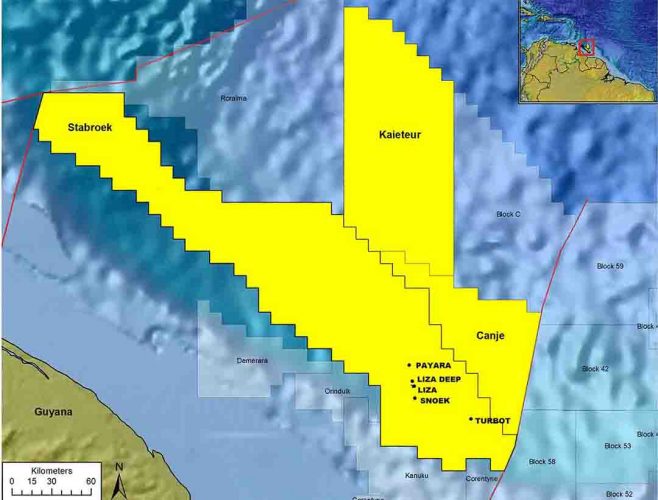Exxon’s new well site looks promising – sources.

Jan 1,2018
ExxonMobil’s oil future looks even brighter here as sources say its Ranger 1 Well which is located in the Stabroek Block and where its subsidiary EEPGL began exploration drilling in October shows promise to be better than Liza and the other four wells that have unearthed commercial oil discoveries thus far.
“Ranger 1 has carbonate play meaning it has a carbonate reservoir feature and from preliminary interpretation of that exploration it has so far showed positive porosity for oil and gas…so yes the prelims are indeed better than at the other wells,” one source told Stabroek News.
However, the source was quick to point out that “it is too early to determine a lot of things” and that “much more testing and evaluation” needs to be done before confirmation on approximate oil and gas bearing capacity.
The Stabroek Block is 6.6 million acres (26,800 square kilometers). Esso Exploration and Production Guyana Limited (EEPGL) is operator and holds 45 percent interest in the Stabroek Block. Hess Guyana Exploration Ltd holds 30 percent interest and CNOOC Nexen Petroleum Guyana Limited holds 25 percent interest.
Last Thursday Natural Resources Minister Raphael Trotman said that thus far oil reserves in the block have been placed at 3.2 billion barrels.
Ranger 1 covers an area of approximately one square kilometer.
Ranger is Exxon’s seventh well exploration and if there is confirmation of another oil find it will be the sixth such well to forecast commercial quantity unrefined petroleum in Stabroek Block that ExxonMobil’s shares with its partners.
According to the company’s project overview of works in the Stabroek Block, the Liza-1 well discovery was announced in May 2015 following drilling. The Liza-2 well was drilled and tested in July 2016 while the Liza-3 well was drilled in October 2016, confirming a world-class resource discovery in excess of 1 billion oil-equivalent barrels.
“Liza-4 well was drilled in March 2017 and encountered more than 197 feet of high-quality, oil-bearing sandstone reservoirs, which will underpin a potential Liza Phase 2 development Appraisal drilling at Liza 3 identified an additional high quality deeper reservoir directly below the Liza field, which is estimated to contain resources between 100 and 150 million oil-equivalent barrels,” ExxonMobil reports.
It said that the Skipjack-1 was drilled in September 2016 but that it did not encounter commercial quantities of hydrocarbons.
Payara-1 well discovery was announced in January 2017; Payara is ExxonMobil’s second oil discovery on the Stabroek Block and was drilled in a new reservoir – encountering more than 95 feet of high quality, oil bearing sandstone reservoirs.
The Payara-2 well discovery was announced in July 2017 and the company explained that Payara-2 encountered 59 feet (18 meters) of high-quality, oil-bearing sandstone reservoirs with its discovery estimated at approximately 500 million oil-equivalent barrels.
Following Payara, Exxon’s third oil discovery well; Snoek-1, was announced in March 2017. The company says it encountered more than 82 feet of high quality, oil bearing sandstone reservoirs and that the well data was being analyzed to better understand the full potential of the well.
Exxon says that exploration of the Turbot well followed Payara and in October of this year the well encountered 75 feet (23 meters) of high-quality, oil-bearing sandstone reservoirs.
It says that the gross recoverable resources for the Stabroek Block are now estimated at 2.25 to 2.75 billion oil-equivalent barrels, including Liza, Liza Deep, Payara, Snoek and Turbot.
No word of Ranger 1’s carbonate encounter is mentioned on the company’s website but it pointed out that following Snoek, the Stena Carron drillship, used in the drilling of its wells, was scheduled to move to the Ranger prospect once. “Further exploration drilling will continue into 2018 in the multiple leads already identified,” the company states.
During a third quarter earnings call in October, Exxon’s Vice President of Investor Relations had said that that overall the company was seeking to get as quickly to the manufacturing phase here in Guyana in an effort to expand its resources as it simultaneously optimised its capabilities.
“If you think about my comments, you really want to get into that manufacturing mode very quickly. If you’ve got the resource – obviously, we’re going to continue our exploration programme, hopefully continue to grow the resource. You want to get into that manufacturing process because that will help continue to progress that learning curve and reduce your overall cost,” he said.
The government on Thursday released the petroleum agreement with EEPGL and it has raised a variety of questions about the deal particularly about the expanded stability clause and the signing bonus that was enshrined within.
